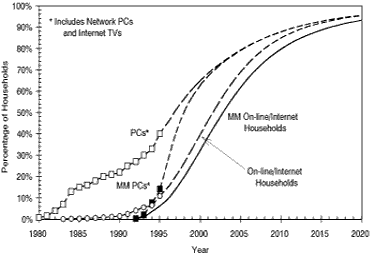
Source: Technology Futures, Inc.
There are several technological alternatives for delivering high-speed digital services to homes. Except for the scenario for LEC delivery, this article focuses on the demand for services, not delivery technology. Nevertheless, it is worthwhile mentioning the alternatives at the outset, if for no other reason than to demonstrate that there is no lack of viable options:
Narrowband Integrated Services Digital Network (ISDN) -- Provides 64 Kb/s to 128 Kb/s access. While superior to analog modems in bandwidth and connect time, narrowband ISDN is likely to be quickly overtaken by technologies with much higher rates. Still, it is now widely available, and in spite of high pricing is seeing some adoption. By virtue of its head start, it will see continued adoption until its competitors catch up in availabiltiy.
Digital Subscriber Line (xDSL) -- This is a family of technologies that provides high-speed digital services on the twisted pair copper cable used by LECs. ADSL is a version of this technology that provides asymmetrical service to homes with downstream bandwidths of 1.5 Mb/s to 6 Mb/s. Other versions will be able to deliver rates of up to 52 Mb/s, but only over short distances; at these rates, xDSL is really a version of FITL, described next.
Fiber-in-the-Loop (FITL) -- Any of several technologies that extend fiber optics very close to the customer. The last link, up to about 1,000 feet in length, may be provided on copper pairs (e.g., xDSL), coaxial cable, fiber, or wireless technology. Installing this technology requires very substantial infrastructure investment by LECs or others, but provides tremendous bandwidth as well as many technical, operational, and cost advantages.
Cable Modems -- Provides 10 Mb/s (more or less on some systems) on existing cable television systems. Like the computers attached to an Ethernet, the bandwidth is shared by a number of customers, so not every customer always has full access to the bandwidth. The technology is not expensive compared with other alternatives, but cable systems may have to upgrade their networks to make them work reliably.
Wireless -- Both terrestrial technologies, such as LMDS, and planned satellite-based systems, such as Teledesic and Motorola's Celestri, are potential competitors to wireline. These technologies, especially the satellite systems, have the advantage of economically reaching widely-dispersed customers, without having to build an expensive terrestrial infrastructure.
Figure 1 shows the forecasts of the percentage of households using PCs, multimedia PCs, and on-line/Internet services. The forecasts for PCs and multimedia PCs include network PCs and Internet TVs capable of supporting multimedia. In this context, multimedia refers to the usage of a combination of text, graphics, images, audio, and/or video in an interactive computer session. The multimedia PC and on-line/Internet forecasts were combined to derive the forecast of multimedia on-line/Internet households shown by the solid line. This forecast is the percentage of households likely to have bandwidth demands that are now being served by analog modems typically operating at 28 Kb/s, but would find higher speeds and digital service very desirable if they were available and economical.
Figure 1: Households Using PCs, Multimedia PCs, and On-line/Internet Services

Source: Technology Futures, Inc.
Very few among these home users are subscribers to digital services today, but we expect the number to increase rapidly as ISDN equipment and services reach the mass market, and as xDSL and cable modem services are introduced. Our forecast for the adoption of all types of home digital services, shown in Figure 2, implies that 1% of all households will use digital services by year-end 1998, 5% by year-end 2000, and 25% by year-end 2005.
Figure 2: Households Using Digital Services
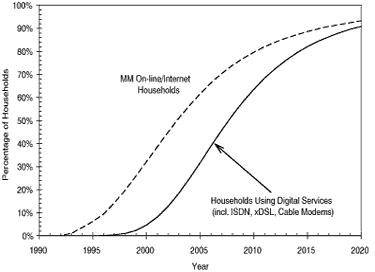
Source: Technology Futures, Inc.
Although narrowband ISDN (64 Kb/s to 128 Kb/s) provides significant advantages over 28 Kb/s modems (and also 56 Kb/s modems) in both bandwidth and access time, the data rate is still insufficient for many multimedia applications. Thus, we expect the market will demand higher data rates. However, narrowband ISDN has already become widely available, while the transition to higher-speed digital services at 1.5 Mb/s and above is dependent on telephone, cable, wireless, or other companies installing the required infrastructure and making services available to residential customers. This means that a forecast of high-speed subscribership must account for the availability of such services. Our forecast of the availability of high-speed services, shown by the left-hand solid line in Figure 3, indicates that 10% of households will have high-speed digital service available by year-end 2001 and 50% by year-end 2005.
Figure 3: Home Digital Availability and Subscribers -- 1.5 Mb/s & Above
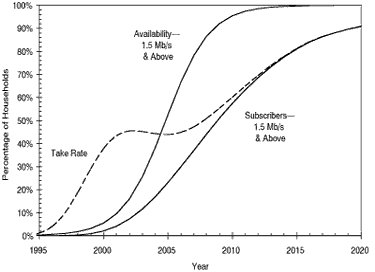
Source: Technology Futures, Inc.
Subscribership is expected to follow availability as high-speed services are rolled out. We expect there to be pent-up demand among existing and prospective digital customers and that the usual relationship, illustrated in Figure 3, among availability, subscribers, and take rate will occur. This implies that about 1% of households will subscribe to these services by year-end 1999 and approach 25% by 2005, as illustrated by the right-hand solid line in the figure.
So far, we have referred generically to high-speed services without specifying a particular rate. Of these, the 1.5 Mb/s offered by the most basic versions of xDSL is the lowest rate. Thus, it represents a technological threshold from the perspective of infrastructure technology. Although cable modems will offer higher access data rates, as will other versions of xDSL, 1.5 Mb/s may also approximate the typical useful data rate for residential multimedia applications for the next several years. This is not because of limitations in the users' multimedia computers or in the requirements of the applications used. Rather, the computer capacity of Internet and on-line service providers, as well as the capacity of the Internet backbone, imposes a practical limit. Thus, we assume that 1.5 Mb/s would be competitive today, setting marketing considerations aside.
We expect these limitations to ease as service provider facilities continue to be upgraded and as capacity and speed are added to the Internet backbone network. We assume that the rate of performance increase is typical of the computer industry -- namely that performance roughly doubles every two years. This means that the minimum competitive rate for access providers will quadruple roughly every four years.
We implement this principle in our forecasting by assuming that the industry progresses through several generations of data rates similar to what we have seen for modems, with a new generation introduced every four years. We have used the nominal rates of 1.5 Mb/s, 6 Mb/s, 24 Mb/s, and 100 Mb/s in our forecasts. The 100 Mb/s category is representative of a group of rates, including the ultimate xDSL rate of 52 Mb/s, 100 Mb/s Ethernet, 50 Mb/s SONET OC-1, and 150 Mb/s SONET OC-3.
Figure 4 shows our forecast of the percentage of households requiring each of these rates. The forecasts assume that, in any given year, different customers demand different minimum rates, because they are different in their applications, perceptions, and willingness-to-pay. However, as with computers, the expectations of all users increase as the technology improves. The forecasts indicate that 1.5 Mb/s will meet the typical user's expectations until about 2005, that 6 Mb/s will do so until about 2010, then 24 Mb/s until 2015, and finally 100 Mb/s thereafter. These forecasts reflect a total life cycle of 10 years for each generation, typical for computer equipment or telephone circuit electronics.
Figure 4: Households Using Digital Services -- Minimum Comparable Data Rates
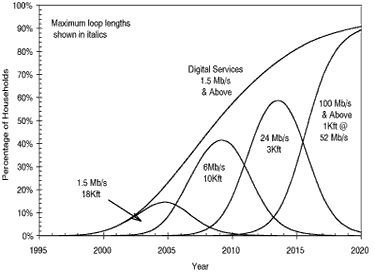
Source: Technology Futures, Inc.
Forecasting identifiable generations of data rates in what is essentially a continuous process may seem strange. The reason we do this is to tie the demands of consumers to specific infrastructure requirements, especially as they relate to LECs deploying xDSL technology. We do this in the companion article, "Three Scenarios for the Adoption of FITL and xDSL," in this issue of NTQ. The xDSL technology is available at specific data rates with specific network requirements at each rate. The most important of these is the maximum length of the segment of copper cable to the user's home, which is shown in Figure 4 for each rate.
The forecasts shown in Figure 4 can be translated back into a forecast of average rates by taking the weighted average of the nominal rates for each year (weighting by the percentage of digital customers at each rate). This yields the dashed line in Figure 5, which matches almost exactly the expected trend, shown by the solid line, based on performance improving at 50% per year, i.e., doubling about every two years or roughly quadrupling every four. This characterization is more useful for providers deploying cable modems. These will offer higher access rates than will xDSL, but the same channel will be shared by a number of users, with the specific number depending, in part, on traffic engineering factors. For these providers, Figure 4 represents likely traffic engineering targets for each user's reliable throughput.
Figure 5: Home Digital Services -- Average Data Rate
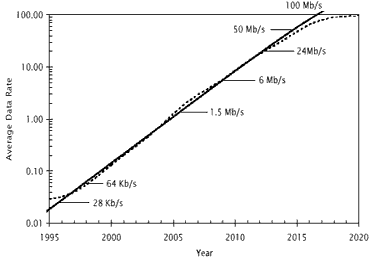
Source: Technology Futures, Inc.
The forecasts described in this article measure the bandwidth needs of subscribers and serve as targets for service providers in terms of the number of customers served at each rate. They assume, of course, that applications will be developed to make use of ever-higher data rates and that consumers will want them. Given the rate of progress since the birth of the PC -- which shows no sign of abating -- this seems likely, especially with HDTV around the corner.
The forecasts also assume that the service will be provided. This also seems likely, given the number of alternatives and the potential size of the market.
The adoption by consumers of high-speed digital services, if these assumptions hold, can provide immeasurable opportunities to players that have the vision and heart to make a new mass market.